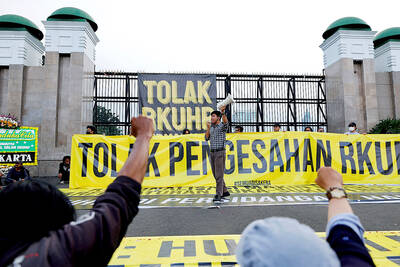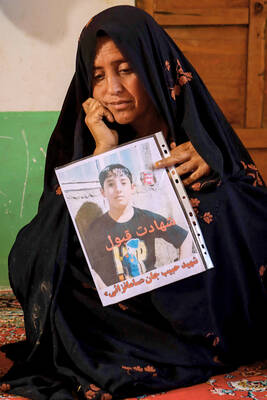Centuries ago Kwanggaet’o the Great ruled over a mighty empire stretching from south of Seoul deep into Manchuria in China’s northeast, but his Koguryo dynasty is now at the center of a historical tug-of-war.
He is revered as a Korean national hero on both sides of the divided peninsula, while Chinese attempts to claim Koguryo as its own have provoked fury among its neighbors.
One of Koguryo’s capitals, now the modern Chinese city of Jian, stands on the Yalu River on the frontier between China and Kim Jong-un’s North Korea. It hosts a treasure trove of historical sites and cultural relics, including royal mausoleums designated as UNESCO World Heritage sites and decorated with murals depicting traditional wrestling and tiger-hunting. A towering stone stele more than 6m tall illustrates the dispute, with Kwanggaet’o’s name carved into the granite — in the classical Chinese characters used for writing in northeast Asia at the time.
“Koguryo is in fact part of Korean history, not Chinese history,” South Korean visitor Hwang Seon-goo said.
“We think that China insists on having its own way,” Hwang added.
Soon afterwards Zhang Ming, who identified himself as a Chinese tourist, expressed keen interest in knowing what the South Korean visitor had said.
In response, he pointed to the language of the inscription as evidence of its Chineseness, asking “how it could be Korean” if it was written in Chinese.
The general Chinese view can be seen in a description in a Jian museum devoted to the dynasty.
“Koguryo was engaged in wars with ancient central China and surrounding nations and tribes,” reads one label.
“However, they finally accepted the authority of ancient central China dynasties and had a main historical trend of tributary kingdom,” it adds.
The sensitivity of the issue is such that a reporter visiting the museum was briefly detained by public security officials, before being ordered to leave Jian and followed out of town.
Koreans on both sides of the divided peninsula claim Koguryo as an inherent part of their history, and it is a popular theme in South Korea for novels and television dramas, such as this year’s The Blade and Petal, a tale of romance and political infighting toward the dynasty’s close.
Koguryo lasted from at least 37 BC until 668 AD, when it was brought down by an alliance between the Chinese Tang Dynasty and Silla, a rival Korean kingdom.
However, the areas governed by the empire, spelled “Goguryeo” in South Korea and “Gaogouli” in China, lie in what today are four modern sovereign states: the two Koreas, China and Russia.
Tensions began rising about a decade ago when China launched what it called the Northeast Project, which was a re-examination of the history of the country’s border areas in the region.
Reaction was particularly negative in South Korea where the move was seen as an attempt to hijack Korean history, and even a possible prelude to Chinese designs on its ally North Korea, were the ruling regime to collapse.
South Korea’s foreign ministry devotes a section of its Web site to the topic, putting it on a par with the row with Japan over the islets in the Sea of Japan (known as the “East Sea” in South Korea), called Dokdo by Seoul and Takeshima by Tokyo.
“The Korean government considers issues concerning the history of Goguryeo to be a matter of national identity, and thus places such issues among its highest priorities,” the Web site says.
In 2006, South Korea’s then-president Roh Moo-hyun reportedly raised the research personally with Wen Jiabao (溫家寶), China’s premier at the time.
Tensions may have eased since, but South Korea still keeps a close eye on “new cases of historical distortion,” according to the foreign ministry.
Adam Cathcart, a lecturer in Chinese history at Britain’s University of Leeds said: “When you look at North Korean relations with China, when you look at South Korean relations with China, it’s an impediment, it’s an irritant, it’s something that all sides are watching.”
Kwanggaet’o, who reigned from 391 to 413 and whose name is often translated as “broad expander of territory,” is known in China as “Haotaiwang.” South Korea spells his name “Gwanggaeto” — and uses it for a class of its warships.
For its part, North Korea — whose government proclaims a “military first” principle — also has numerous sites related to Koguryo and sometimes invokes the dynasty in its propaganda.
“Koguryo martial valor is something that is seen as very desirable from an historical exemplary point of view... for the North Korean leaders,” said Cathcart, an expert in relations between Beijing and Pyongyang.
North Korea’s young leader — who recently had his uncle executed — would undoubtedly want to visit the ancient tombs in Jian, he added.
“That’s a photo op to die for, for Kim Jong-un,” he said.

Indonesia yesterday began enforcing its newly ratified penal code, replacing a Dutch-era criminal law that had governed the country for more than 80 years and marking a major shift in its legal landscape. Since proclaiming independence in 1945, the Southeast Asian country had continued to operate under a colonial framework widely criticized as outdated and misaligned with Indonesia’s social values. Efforts to revise the code stalled for decades as lawmakers debated how to balance human rights, religious norms and local traditions in the world’s most populous Muslim-majority nation. The 345-page Indonesian Penal Code, known as the KUHP, was passed in 2022. It

‘DISRESPECTFUL’: Katie Miller, the wife of Trump’s most influential adviser, drew ire by posting an image of Greenland in the colors of the US flag, captioning it ‘SOON’ US President Donald Trump on Sunday doubled down on his claim that Greenland should become part of the US, despite calls by the Danish prime minister to stop “threatening” the territory. Washington’s military intervention in Venezuela has reignited fears for Greenland, which Trump has repeatedly said he wants to annex, given its strategic location in the arctic. While aboard Air Force One en route to Washington, Trump reiterated the goal. “We need Greenland from the standpoint of national security, and Denmark is not going to be able to do it,” he said in response to a reporter’s question. “We’ll worry about Greenland in

PERILOUS JOURNEY: Over just a matter of days last month, about 1,600 Afghans who were at risk of perishing due to the cold weather were rescued in the mountains Habibullah set off from his home in western Afghanistan determined to find work in Iran, only for the 15-year-old to freeze to death while walking across the mountainous frontier. “He was forced to go, to bring food for the family,” his mother, Mah Jan, said at her mud home in Ghunjan village. “We have no food to eat, we have no clothes to wear. The house in which I live has no electricity, no water. I have no proper window, nothing to burn for heating,” she added, clutching a photograph of her son. Habibullah was one of at least 18 migrants who died

Russia early yesterday bombarded Ukraine, killing two people in the Kyiv region, authorities said on the eve of a diplomatic summit in France. A nationwide siren was issued just after midnight, while Ukraine’s military said air defenses were operating in several places. In the capital, a private medical facility caught fire as a result of the Russian strikes, killing one person and wounding three others, the State Emergency Service of Kyiv said. It released images of rescuers removing people on stretchers from a gutted building. Another pre-dawn attack on the neighboring city of Fastiv killed one man in his 70s, Kyiv Governor Mykola